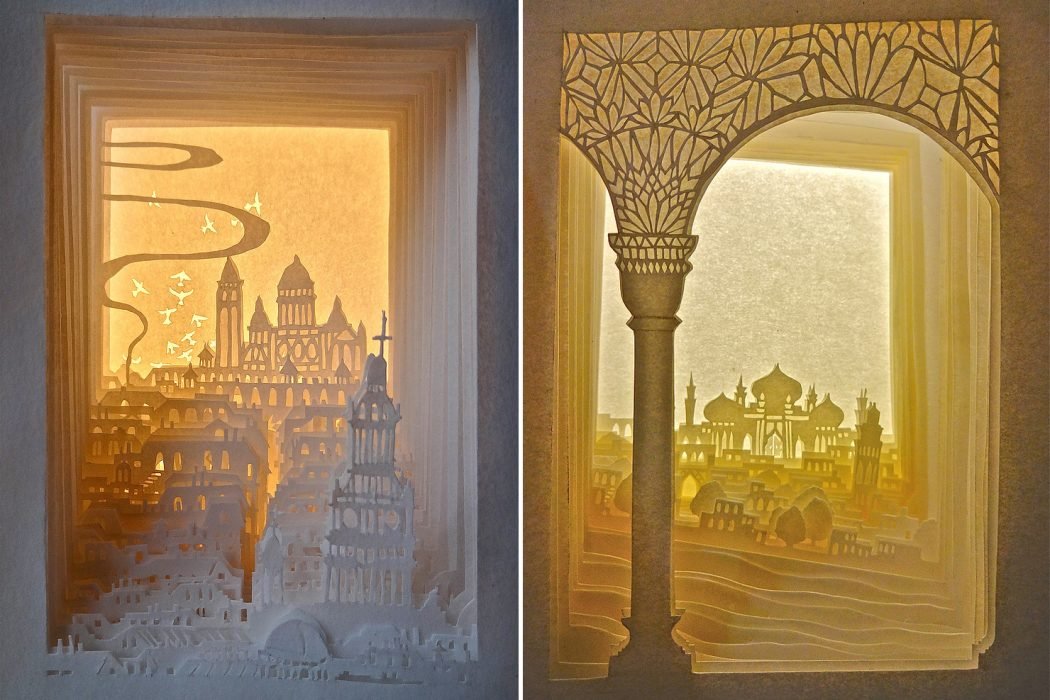Imagine a world of fairytales come to life, of nature spirits, and enchanted forests. Cities illuminated by Moroccan stars and the glow of Parisian street lamps. Worlds so small they can fit inside a bell jar or notebook and others so large you can get lost inside. And what if we were to tell you these worlds were cut out of paper? Magic born from the blank pages of a book and woven from the purest of imaginations. Japanese artist Ayumi Shibata is the weaver of such worlds. She cuts from paper the most intricate miniature creations to immersive, life-sized installations. With her distinctly Japanese aesthetic and inspirations from “kami” spirits that reside in all living things, she breathes magical life into everything her knife touches. Writers and authors across time would agree that there is nothing more intimidating than a blank page, but for Ayumi, white paper is a portal into a world of dreams as endless as the imagination.
Origin Story…
“Because my mother is a quilt and patchwork maker, I started to play with needles, string and left over fabrics in her atelier shop and at home when I was a child. That is the foundation of my art. When I was a teenager, I got into music. I sang and wrote songs. Music was the way that I expressed myself at that time. When I moved to New York, I started to make art pieces by paper and taking a stained glass workshop. I enrolled in the Printmaking and Sculpture, Mixed media department for four years in the National Academy School in New York under Maurizio Pellegrin and Kathy Caraccio. During that time in NY, I had several group shows and two solo shows in soho,NY and Omote-sando, Tokyo. In 2015, I moved to Paris.”
On “Kami” Spirits…
“Kami” is the Japanese word that means god, divinity, or spirit, and it also means “paper.” In Japanese worship and in my religion of Shinto, invisible “Kami” spirits dwell in various objects and events, places, as well as in our houses and in our bodies. Ya-o-yorozu no kami, (which literally means eight millions of spirits, uncountably many spirits) who live together all around in Japan.”Kami”are connected to nature. They move freely beyond time and the universe. Also “Kami” dwell in paper. In the religion of Shinto, paper is considered a sacred material. I cut paper to express my thankfulness to the “Kami” spirits for having been born in this life. Each cut, each page is a prayer. My process helps me to be quiet and clear my mind in meditation or prayer. I purify my soul through the act of cutting paper. By interacting with the “Kami” spirit material, I can connect to this spirit world with our own.”
On Relativity…
“Everything in life is relative. When ants walk next to sky scrapers, they never realize what they are walking next to. When compared to a daisy, a sunflower appears to be giant, but when it lies amongst the old oak trees, it appears small and inconsequential. In the same way, scale and proportion are important to the viewers relationship and viewing experience. Large works of art invite the viewer to be swallowed by the visual world they are engaging with. Small art works keep the viewer in the position of an outside observer. We observe small works as if looking through a key hole into another world; constantly aware of our outsider status.”
Inspirations…
“I like to watch the lectures about theoretical physics and cosmology, I imagine myself traveling in another dimension or world. As I cut out each page by page, I create the multiple dimensions in my work. I am currently reading a book called ‘Le Citta Invisible” by Italo Calvino, and I imagine that I am traveling through cities in another world.”
On Paris and Identity…
“My experience in Paris has given me the opportunity to exchange and digest the variety of ways of thinking. spending my time in different cultures and customs expands my identity every day. Understanding others will help me to know more about myself. Spending time in different cultures, helps to remind me of my identity as Japanese.”
On Paper Secrets…
“Paper has personality, like humans. I communicate with it. It is important for me to understand the personality of each piece of paper. For example, the way the light effects it, the effects of the darkness, the thickness, the strength, how the humidity interacts with it, and what is it made of. I choose the paper for each project by considering its personality.”







